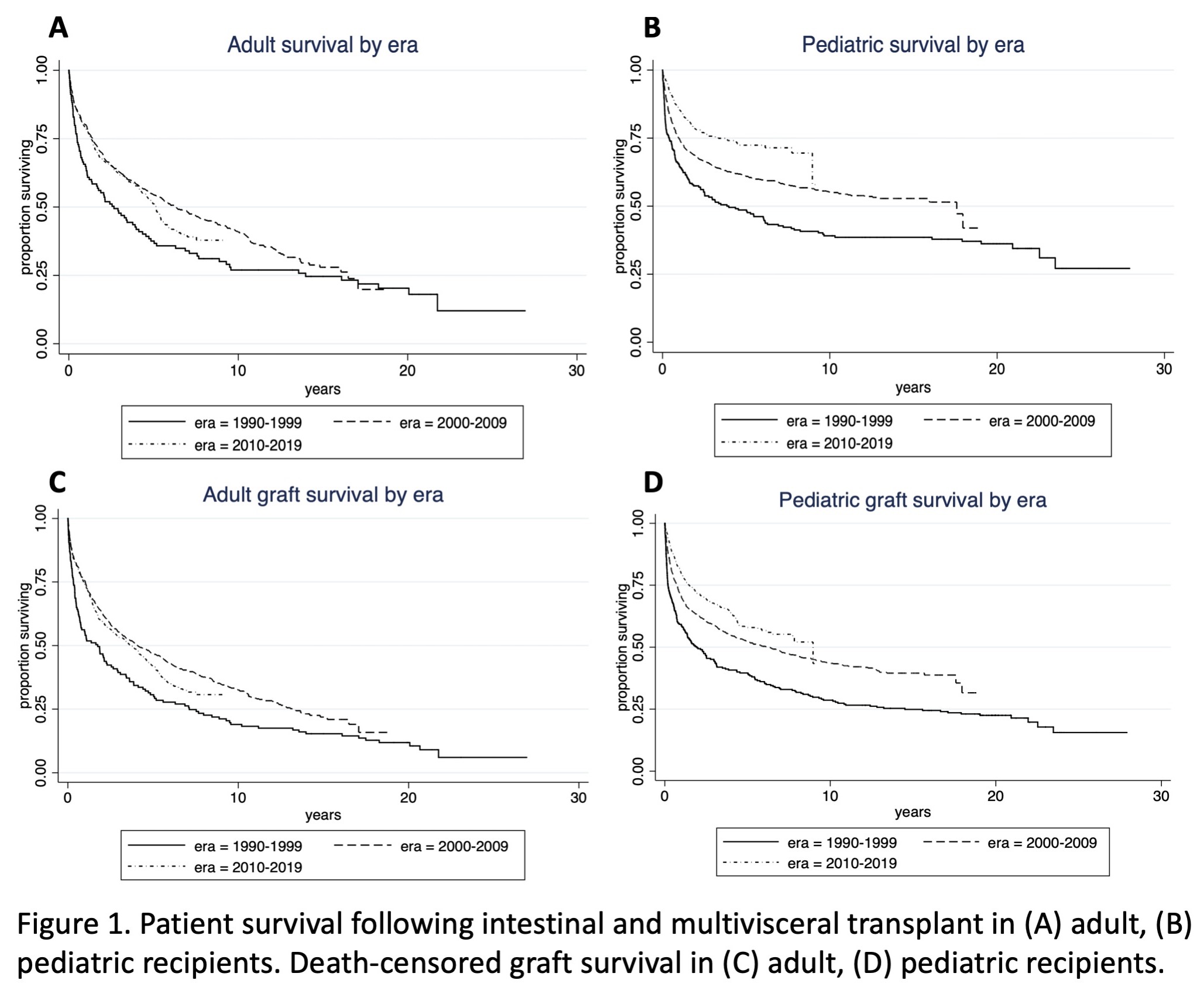Trends in Intestinal and Multivisceral Transplantation in the United States over 30 Years
1Surgery, Duke University Hospital, Durham, NC, 2Ped Gastroenterology, Seattle Childrens' Hospital, Seattle, WA, 3Gastroenterology, Henry Ford Hospital, Detroit, MI, 4Gastroenterology, Duke University Hospital, Durham, NC, 5Gastroenterology, Mt Sinai Hospital, New York, NY, 6Transplant Pharmacy, Henry Ford Hospital, Detroit, MI
Meeting: 2020 American Transplant Congress
Abstract number: 303
Keywords: Intestinal transplantation, Multivisceral transplantation, Outcome, Pediatric
Session Information
Session Name: Intestinal Transplantation
Session Type: Oral Abstract Session
Date: Saturday, May 30, 2020
Session Time: 3:15pm-4:45pm
 Presentation Time: 4:03pm-4:15pm
Presentation Time: 4:03pm-4:15pm
Location: Virtual
*Purpose: We describe trends in intestinal transplantation use and outcomes over time in the USA.
*Methods: We use the cohort of intestinal and multivisceral transplants 1990-2019 in the UNOS/SRTR datasets. Eras were defined as 1990-1999, 2000-2009, 2010-2019. Summary statistics were calculated by era. Patient and death-censored graft survival were assessed by era, stratified by pediatric (<18 years at transplant) and adult recipients.
*Results: A total of 3035 transplants were performed, 398 in the first era, 1485 in the second, 1152 in the third. The proportion of adult recipients increased over time (35%, 44%, 59% respectively). The number of infant (<5 years) recipients decreased in the last decade (45%, 44%, 26%). More transplants were performed in recipients with a previous intestinal transplant over time (8%, 9.6%, 12.2%). Fewer livers were included in multivisceral grafts (60% , 56%, 48%). The number of grafts including the duodenum, large intestine, or stomach increased over time. The most common indication for intestine-only and multivisceral transplants in adults remained short gut syndrome (66% in era 3). In children, intestine-only grafts were most commonly used for functional bowel problems (22% in era 3), and multivisceral grafts for gastroschisis (23% in era 3). 1- and 5-year survival improved over time in children (First era: 65%, 46%; second era 75%, 60%; third era 85%, 72% respectively. KM log rank era 2 vs. 3 p<0.0005), while adult survival plateaued (First era: 65%, 37%; second era 79%, 54%; third era 77%, 51%, respectively. KM log rank era 2 vs. 3 p=0.15). A similar trend was observed in death-censored graft survival (Figure 1).
*Conclusions: A greater proportion of intestinal transplants are now being done in adults, perhaps as a result of improving intestinal rehabilitation in pediatric patients. Graft and patient survival has plateaued for the past decade, highlighting the ongoing need for improving long-term outcomes in adult recipients. As technique and outcomes improve, re-transplantation has become a feasible option in those patients who need it.
To cite this abstract in AMA style:
Samoylova ML, Yerxa J, Shaw BI, Horslen S, Jafri S, Mavis A, Schiano T, Summers B, Barbas AS, Sudan DL, Segovia MC. Trends in Intestinal and Multivisceral Transplantation in the United States over 30 Years [abstract]. Am J Transplant. 2020; 20 (suppl 3). https://atcmeetingabstracts.com/abstract/trends-in-intestinal-and-multivisceral-transplantation-in-the-united-states-over-30-years/. Accessed December 23, 2025.« Back to 2020 American Transplant Congress

